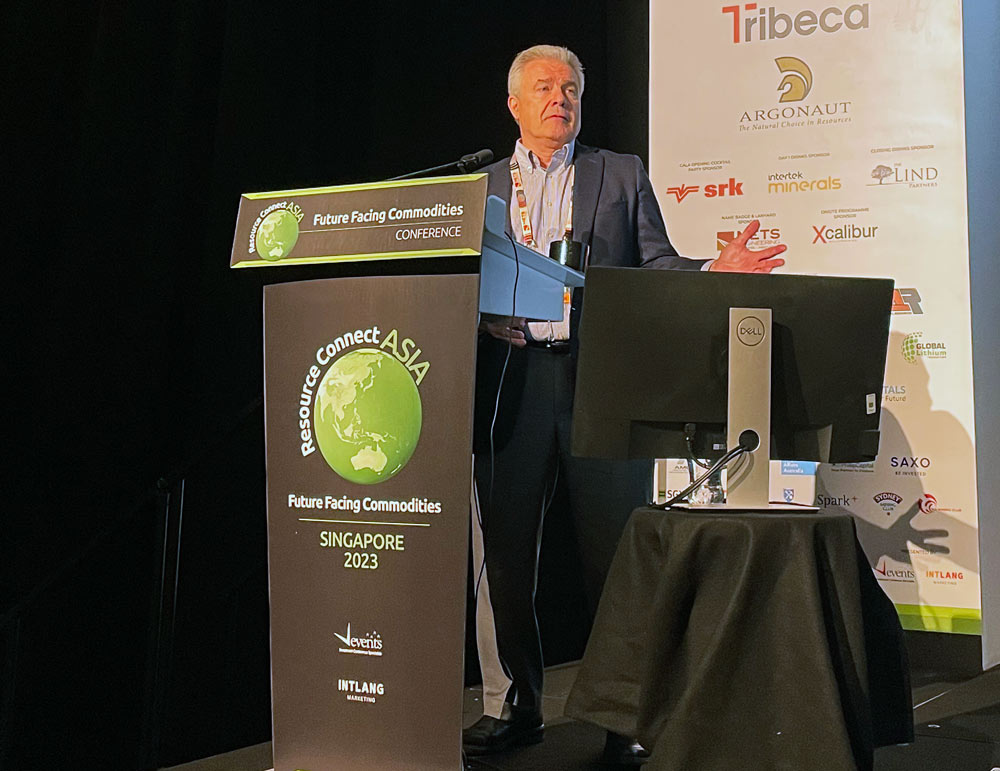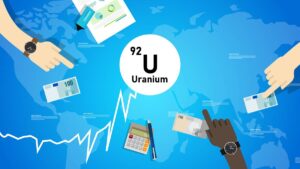Mr Lithium: China is creating a ‘false narrative’ to talk down lithium prices as industry struggles to build mines on time

Pic: PM Images, Stone/ Getty Images
- Lithium prices have been falling in China this year, but an international expert says this is still the lithium decade
- Market has grown from just US$200 million three decades ago to over US$40 billion today, most of that growth in the past eight years
- Miners see long term supply shortages as they race to bring new operations online
Lithium has fallen over 50% in 2023, so far, with one of the world’s foremost experts in the key battery metal saying major consumer China is creating a “false narrative” to talk prices down.
After a stunning 2022, sentiment has been damaged in 2023 as lithium prices in China retreat despite a continued expansion in EV sales.
But ‘Mr Lithium’ Joe Lowry, who saw the lithium sector grow from a US$200 million when he entered the game in 1990 to US$1b by 2015 and over US$40 billion today, believes lithium supply will continue to disappoint even as Governments and automakers in the USA and Europe throw money at the sector.
“Everybody knows they have a lithium problem and we’ve seen this year at the beginning of the year, extreme volatility in the China spot market,” he said in a keynote at Vertical Events and Tribeca Investment Partners’ inaugural Resource Connect Asia event in Singapore today.
“What’s that all about? I think you’re going see volatility in the lithium space going forward. I believe honestly, that China’s tried to create a false narrative to talk the lithium price down.
“It’s going to be interesting, but … the way I look at the numbers we’re in a shortage for the rest of this decade.
“And even though there may be mismatches between supply and demand and pricing, making it volatile, the long term lithium price is going to tend towards high and not low.”

World needs 13 additional Pilbara Minerals-sized producers by 2025
How close are we to solving the supply shortfall?
While Lowry’s own projections are more conservative, he noted that Albemarle, America’s largest and quickest horse in the lithium game, says 1.8Mt of lithium carbonate equivalent will be needed by 2025 to meet demand.
By 2030 it thinks 3.7Mt will be needed — 10x 2020 levels — matching 4700GWh of battery capacity from EVs and energy storage technology, up from 690GWh last year.
“If we framed Albemarle’s numbers in terms of what it’s going to take from a project perspective to meet that demand, 1.8 million tons in 2025 would be 1.1 million tonnes more than the market produced last year,” Lowry noted.
“That would take 25 world class brine projects to come online in three years. I promise you that is not going to happen.
“If you want to frame it from Western Australian mining, that would be the equivalent of six Greenbushes (on) 2022 production (the world’s biggest hard rock mine).
“That would be the equivalent of 13 times what Pilbara Minerals (ASX:PLS) are going to do this year.
“There are a lot of new lithium projects out there but from an execution perspective you are not going to see a response that meets that kind of demand.”
Where is supply going to come from?
In order for prices to correct to 2020’s lows supply would most likely need to somehow outstrip demand.
And lithium’s dirty little secret, Lowry reckons, is the industry has never built a mine on time.
He expects only half of the multitude of brines planned in South America’s Lithium Triangle will come online, noting what was once the largest source of lithium around the world has stagnated, outside of Chilean giant SQM’s tripling of production in the Atacama Basin.
Livent, for instance has delivered virtually no growth in a decade, while Allkem’s (ASX:AKE) Olaroz remains the last new operation in Argentina eight years on from its 2015 opening.
So where will the lithium come from?
Australia is the obvious growth engine for lithium supplies, but even there supply is likely to disappoint.
Canada is another option.
The Inflation Reduction Act, which will deliver billions in tax credits to companies producing EVs with raw materials sourced from the US and free trade aligned nations like Canada and Australia, has heightened the role of those nations in the energy transition.
“Quite honestly, as an American, I love what we’re trying to do in saying we’re going to build a robust battery supply chain in North America,” Lowry said.
“Because now politically, the US essentially considers Canada the 51st state in terms of critical minerals.
“Canadians don’t like to hear that much, but that is in fact how that’s playing out.”
Lowry says Canada “wants to become the Australia of North America”.
“And I hope they do, but Quebec like to tout they have a great educated workforce and their low hydro cost,” he said.
“But Quebec’s been trying to produce lithium for 15 years and only this year will you reopen a mine and it’s going to be relatively small.
“There was a FT article this week that basically framed it the way Canaccord says it now … lithium projects are three years late on average. I think it’s a little worse than that.”
Harder than you expect
That mine has just been reopened by Sayona Mining (ASX:SYA), which owns 75% of the 226,000tpa North American Lithium spodumene operation in Quebec alongside fellow ASX-listed miner and 25% owner Piedmont Lithium (ASX:PLL).
Sayona’s finance manager Dougal Elder told Stockhead on the sidelines of the Resource Connect Asia conference it will likely be two years before another major North American spodumene supplier, the nearby Whabouchi mine owned by TSX listed Nemaska Lithium, comes online.
Sayona could also become the first lithium carbonate supplier in Canada in a couple of years, with a PFS into finishing a half-completed plant at the NAL site due to be released to the market soon.
Elder says the Canadian and Quebec Governments are “incredibly supportive” of new lithium producers but said the permitting requirements there are extensive.
“NAL is probably in a unique position, in that it’s probably going to be the only significant producer of lithium in North America for a couple of years,” he said.
“And I think that just speaks to the challenges around developing mines.
“It’s easy to build downstream lithium, chemical or battery plants in a couple of years. But getting a mine off the ground can be five to seven years.
“Canada is a very good jurisdiction, Quebec is very supportive of the development of resources there, but certainly I think developing greenfield projects is a challenge, particularly with permitting.
“The permitting is quite extensive in Canada, compared to say other jurisdictions (like) Western Australia.”
Contract prices to remain strong
While lithium spot prices are falling from record highs, Lowry says higher contract prices between miners and offtakers mean average prices paid for lithium chemicals in 2023 will average “substantially higher” than in 2022.
“It’s not the spot price where most of the volume is moving, it’s contract price and contract prices are on formulas,” he said.
“In 2022 there were contracts selling less than $10,000 a tonne. Those will come off, they’re gradually rising.
“If you look at the import statistics from Japan, Chinese material was still moving into Japan in February at over US$80,000.
“So when you read this “the sky is falling because the Chinese spot price is low,” there’s almost no volume moving at those prices right now.”
And what many investors may not appreciate is producers could be generating incredible margins at lithium prices far lower than current levels — spot spodumene still rocking at almost US$5000/t after scaling a previously unthinkable US$8000/t last year.
“The aberration of prices going to US$8,000 a tonne has probably surprised a lot of people and is certainly not sustainable for the long term,” Sayona’s Elder said.
“I think prices will correct over time, the question is how long does it take and the speed at which it gets to that level.
“Prices around that (US$2000/t) level are sustainable, which means that producers are making money, the chemical converters are making money and the end use applications like batteries for electric vehicles are priced affordably for end consumers.”
Sayona Mining (ASX:SYA) share price today:
The folly of the big banks
A number of projections from big banks have shaken the lithium industry over the past 12 months.
Goldman Sachs has been a forerunner in believing China’s ramp up in low quality lepidolite production will see the supply-demand balance shift into over supply.
Lowry disagrees there, but also notes some analysts have prices dropping hard in the coming years despite also projecting major supply shortfalls.
“If you listen to my podcasts Morgan Stanley’s kind of my global whipping boy because they just come out with some bizarre numbers and they predict a 500,000 tonne shortage of lithium in 2030,” he quipped.
“They predict US$1100/t spodumene but they have carbonate at US$8300/t.
“If you do the math on those numbers they make that makes absolutely no sense in any universe.”
Demand still strong from customers
Miners and advanced explorers say demand and the struggle to secure supplies remains strong, as evidenced by Albemarle’s rejected US$5.5 billion offer to buy out near term WA producer Liontown Resources (ASX:LTR) last month.
Global Lithium (ASX:GL1) managing director Ron Mitchell, recently invited by the London Metals Exchange to become the chair of a new combined lithium and cobalt committee, says downstream demand was strong enough to suggest the market will remain short of lithium.
GL1’s Manna and Marble Bar projects in WA, which contain a combined 50Mt at around 1% Li2O make it one of a handful of prospective new lithium miners in Australia.
“The downstream discussions we’re having as a company and the industry is having more broadly gives me the greatest confidence that this market is going to remain short,” he said.
“Getting new projects up is challenging, and each jurisdiction’s got its own set of challenges, whether they are commercial, technical, geopolitical, or infrastructural.
“I’m not just looking at a drop in lithium pricing in the short term. I think medium to long term, the outlook’s tremendous for the sector.”
Mitchell says Albemarle’s bid for Liontown shows WA’s hard rock spodumene remains the product of choice and the underlines the scarcity of quality hard rock resources.
“You’ve got the world’s biggest lithium producer, that’s US-domiciled, that’s looking not to acquire an asset in their own backyard, they’re coming to Western Australia to invest in a project that is still being developed,” he said.
“That talks spades about the future of hard rock, as the markets interpreting it, and there aren’t many JORC-compliant lithium resources around.
“Obviously, companies like ours are looking to fasttrack getting to development as quickly as possible. Liontown’s in a great position, I’m not surprised they pushed back.
“It’ll be interesting to see where that settles but I’d be very surprised if Albemarle walks away from this deal, I’m pretty sure they’d be back at the table.”
Aussie lithium superpowered by IRA
The IRA will help Australian producers as much as Canadian ones, Mitchell believes, as the US and European Governments and carmakers look to grab market share in the e-mobility supply chain.
“Joe talks about lithium saying it’s a metal for the next decade,” he said.
“In my view, it’s a metal for the next century. We’re in an enormous supercycle here for battery metals more broadly and certainly I think the view is demand going forward is fundamentally strong.
“It’s going to take a collective effort, not only at the private level and public company level, but certainly governments have a critical role to play in terms of policy setting.
“I think the IRA has opened some some incredible opportunities for those nations that have free trade agreements with the US, including Japan, Korea, and obviously ourselves here in Australia.
“So I think there’s wonderful opportunities for the further development of West Australian lithium resources and other battery metals on the back of the IRA.”
Global Lithium (ASX:GL1) share price today:
Related Topics

UNLOCK INSIGHTS
Discover the untold stories of emerging ASX stocks.
Daily news and expert analysis, it's free to subscribe.
By proceeding, you confirm you understand that we handle personal information in accordance with our Privacy Policy.








